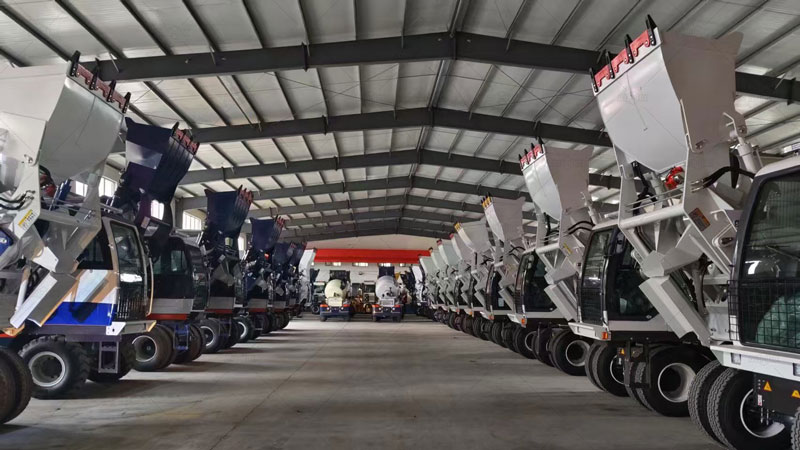In the construction industry, equipment efficiency and durability are critical for ensuring smooth project execution. Among modern solutions, the self-loading concrete mixer has become an essential machine for many construction projects across Latin America. These mobile units integrate batching, mixing, transporting, and discharging functions into a single vehicle, offering clear time and labor savings. However, even the most well-designed mixers contain wear parts that require scheduled replacement. Understanding replacement cycles and the total lifecycle cost helps contractors minimize downtime and optimize return on investment.
Key Wear Parts In A Self-Loading Concrete Mixer
The reliability and mixing quality of a self-loading concrete mixer(autohormigonera) depend on several wear-prone components. Regularly inspecting and replacing these parts before catastrophic failure is a best practice that protects schedules and budgets.
Mixing Blades And Drum Lining
Mixing blades and internal drum linings experience constant abrasive contact with aggregates. Their wear pattern directly affects mixing uniformity and cycle time. Depending on aggregate hardness and impurity levels, mixing blades typically require replacement every 800–1,500 operating hours. Using harder alloys or reinforced linings can extend life but raises initial cost.
Hydraulic Components
Hydraulic pumps, cylinders, seals, and hoses are vulnerable to pressure cycles, contamination, and heat. Seals and hoses should be inspected every six months under moderate use; heavy-use sites may need quarterly checks. Replacing seals and hoses early prevents pump damage, which would be far more expensive.
Transmission, Drive Train, And Bearings
Transmission gears, clutches, and bearings endure high torque and repetitive stress. Proper lubrication schedules and vigilant monitoring for abnormal noise or vibration can double component lifespan. Ignoring early symptoms often leads to complex drivetrain repairs with significantly higher costs.
Tires, Axles, And Chassis Components
Tires and axles are particularly stressed when mixers operate on uneven rural roads or in remote sites. Tire life varies widely based on terrain — urban projects may see multiple seasons, while rough quarry-to-site cycles can necessitate replacement within a year.
Replacement Cycles And Factors Affecting Lifespan
Replacement cycles are not universal; they depend on usage intensity, material characteristics, operator behavior, and environmental conditions. Contractors should build maintenance schedules tailored to real-world operating data rather than relying solely on manufacturer estimates.
Material Influence On Wear Rates
Raw material properties — aggregate hardness, abrasive content, moisture, and presence of clay or iron — significantly influence wear. High-silica aggregates or materials with elevated sand and clay content increase abrasion, shortening blade and lining life. When sourcing materials locally, consider lab testing to estimate wear impact and adjust maintenance plans accordingly.
Operator Practices And Load Management
Operator training matters. Overloading the drum, failing to follow recommended mixing cycles, or using excessive water can accelerate wear. Simple operator protocols — load sequencing, avoiding foreign objects, and adhering to designed mixing times — yield measurable parts-life improvements.
Cost Analysis Of Replacement And Total Ownership
Understanding the cost of replacement parts requires accounting for direct part costs, labor for replacement, and indirect downtime losses. In Latin American markets, logistics and supply chain factors also play a large role in total cost of ownership.
Direct Part Costs
Mixing blades and small wear items are relatively affordable but recur frequently. Hydraulic components and major drivetrain parts have higher unit costs and may require specialist installation. Sourcing OEM parts often ensures fit and reliability, but aftermarket alternatives can offer cost savings if quality is verified.
Indirect Costs And Downtime
Unplanned downtime is the most expensive outcome. A stalled mixer can halt concrete supply to multiple tasks on a jobsite, cascading into schedule penalties and idle labor costs. Prioritizing preventive replacement based on predictable cycles reduces these indirect expenses considerably.
Practical Strategies To Reduce Replacement Costs
Contractors can adopt several pragmatic approaches to lower overall maintenance spend while maintaining performance.
Preventive Maintenance And Monitoring
Implement routine inspections, scheduled lubrication, and condition-based replacement. Recording operating hours and part history creates a predictive maintenance regime that minimizes surprises.
Material Sourcing And Preprocessing
Choosing cleaner aggregates and employing simple preprocessing (screening to remove fines and organics) reduces abrasive wear. When planning projects in Colombia or Peru, evaluate local material characteristics and logistics: the self-loading concrete mixer price Colombia(autohormigonera precio colombia) and local market conditions often reflect both machine cost and expected maintenance patterns. Likewise, buyers researching the self-loading concrete mixer Peru market should factor in material sources and part availability into purchase decisions.
Local Parts Stocking And Supplier Relationships
Establish relationships with regional distributors to shorten lead times. Stocking commonly replaced consumables — seals, blades, filters — on site avoids costly downtime. For Latin American operations, balancing the higher up-front cost of local inventory against the risk of long import lead times is essential.
Operator Training And Standard Operating Procedures
Training operators in best practices reduces misuse-related wear. Documented SOPs for loading, mixing, cleaning, and shutdown extend component life and stabilize concrete quality.
Conclusion
Effective parts replacement planning transforms the self-loading concrete mixer from a source of unpredictable cost into a predictable, high-value asset. By understanding the primary wear parts, establishing realistic replacement cycles based on local materials and operating conditions, and adopting preventive strategies — from material preprocessing to operator training — contractors can manage both direct and indirect costs. When evaluating purchase options, consider not only the machine price but also the local supply chain realities reflected in self-loading concrete mixer price Colombia and self-loading concrete mixer Peru(autohormigonera perú) discussions. A well-maintained mixer keeps projects on schedule, improves concrete consistency, and protects margins across the lifecycle of the equipment.


Comments
October 1, 2025 04:45
성인웹툰
해피툰은 다양한 무료 웹툰, 웹툰 미리보기 사이트, 웹툰 사이트 순위, 무료 웹툰 사이트를 제공하는 사이트입니다. 해피툰의 가장 빠른 주소로 안내해드리겠습니다. no1 무료 웹툰 사이트를 이용해보세요.
https://xn–z27bt9c1e.com